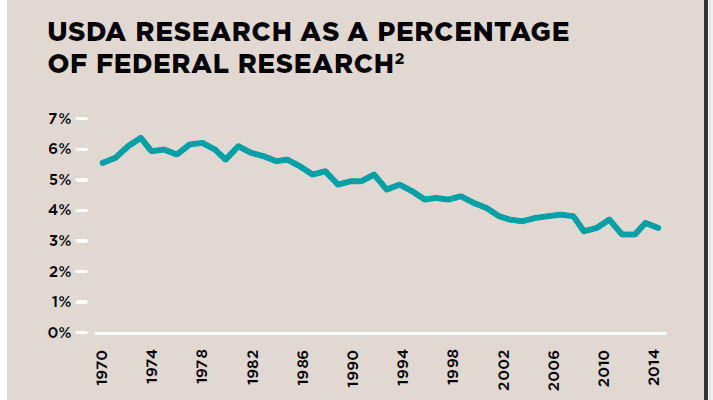New report highlights ag research breakthroughs
SoAR report identifies advances and innovative research in animal and plant sciences.
March 2, 2017

Food and agricultural scientists have to do more research to help farmers produce more with less. Although the federal research budget has grown more than 15 times since 1970, the U.S. Department of Agriculture’s share of that budget has declined.
This is a main message being delivered by the Supporters of Agricultural Research (SoAR) Foundation in briefings on Capitol Hill March 2 as well as in its new report. In collaboration with 11 partnering universities, the SoAR Foundation released its new report, "Retaking the Field—Strengthening the Science of Farm & Food Production," which explores research projects funded by the Agriculture & Food Research Initiative (AFRI) of USDA's National Institute of Food & Agriculture (NIFA) at each institution.
The report tells stories about exciting advances and innovative research in the animal and plant sciences from Cornell University, Iowa State University, Kansas State University, Michigan State University, North Carolina Agricultural & Technical State University, Pennsylvania State University, Ohio State University, Texas A&M University, University of California-Davis, University of Nebraska-Lincoln and Virginia Polytechnic Institute & State University.
“The drought in federal funding of food and agricultural research still exists, but farmers need a flood of research breakthroughs, and AFRI’s limited budget only allows for a trickle,” Thomas Grumbly, president of the SoAR Foundation, said.
The new "Retaking the Field" report — the second in the SoAR Foundation’s series — shows how scientists are solving some of the thorniest questions in food production, despite USDA’s limited research budget. Even as the research budget for all federal agencies has climbed, USDA’s share has nearly been cut in half.
Grumbly noted that AFRI’s funding levels illustrate this trend. The program, which was first established in the 2008 farm bill, currently receives only half of its authorized funding level of $700 million. As a result, the rate at which proposals for AFRI funding receive approval hovers just above 10% -- far below the rates found in European countries and elsewhere.
“Researchers are solving some of the most important problems that farmers face -- from bovine respiratory disease, which infects more than one out of every five beef cattle in feedlots, to rice and wheat rust, which keeps evolving to overcome scientists’ efforts to breed resistance," Grumbly pointed out. "Too often, their success hinges on whether they secure enough funding to keep the lab doors open. Too much top-quality, high-impact research is unfunded and left on the cutting room floor.”
The 11 groundbreaking research teams profiled in "Retaking the Field" include:
1. Cornell University—Dr. Susan McCouch and colleagues cross-referenced genetic details with climate and harvest data over the past 40 years for every rice growing region in the U.S. to help plant breeders develop new weather-specific varieties.
2. Iowa State University—Dr. Hongwei Xin and colleagues developed adaptations for cage-free egg production systems that improve indoor air quality and allow more farmers to respond to consumer demand by adopting cage-free systems.
3. Kansas State University—Dr. Barbara Valent and colleagues examined the blast fungus, which has long afflicted rice crops and now infects wheat fields, to determine new ways for plants to resist the pathogen and overcome its ability to evolve.
4. Michigan State University—Dr. Gale Strasburg and colleagues examined the impacts of heat stress on turkey muscle development and, in developing methods to boost heat stress tolerance, are helping farmers produce better meat.
5. North Carolina Agricultural & Technical State University—Dr. Jianmei Yu and colleagues devised a process that removes 98% of the major allergens in roasted peanuts using a naturally occurring enzyme and then engineered the process to treat raw peanuts as well.
6. Ohio State University—Dr. Chang-Won Lee and colleagues examined and catalogued the microbiome in a chicken’s respiratory tract -- the first step in developing management systems that can lower the level of pathogens hurting production.
7. Pennsylvania State University—Dr. Gary Felton and colleagues analyzed how the saliva of caterpillars and other insect excretions trigger the defenses of crop plants, providing a new path for plant breeders to explore as they develop more resistant cultivars.
8. Texas A&M University—Dr. James E. Womack and colleagues found at least 150 regions of the cattle genome that could be associated with resistance as well as susceptibility to bovine respiratory disease in beef and dairy cattle.
9. University of Nebraska-Lincoln—Dr. Daniel C. Ciobanu and colleagues identified genetic markers in sows associated with earlier onset of puberty, allowing the pigs to produce more litters in their lifetime and increasing production efficiency.
10. Virginia Tech—Dr. John McDowell and colleagues developed new tools for identifying and managing the oomycete pathogens that plague soybeans and other row crops. They also discovered a separate oomycete genus.
11. University of California-Davis—Dr. Jorge Dubcovsky and colleagues have mapped out more than 90,000 genetic markers in wheat plants and identified the markers that are linked to further increases in productivity and resistance to dangerous pathogens.
You May Also Like

.png?width=300&auto=webp&quality=80&disable=upscale)

